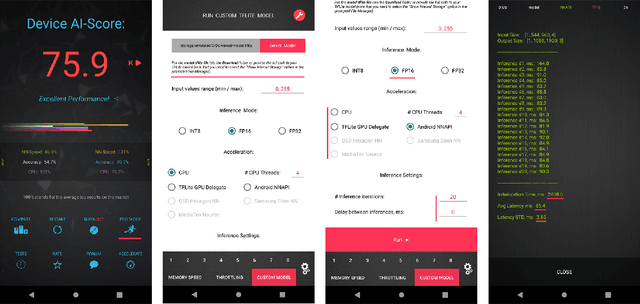Donghao Liu
Fast Camera Image Denoising on Mobile GPUs with Deep Learning, Mobile AI 2021 Challenge: Report
May 17, 2021



Abstract:Image denoising is one of the most critical problems in mobile photo processing. While many solutions have been proposed for this task, they are usually working with synthetic data and are too computationally expensive to run on mobile devices. To address this problem, we introduce the first Mobile AI challenge, where the target is to develop an end-to-end deep learning-based image denoising solution that can demonstrate high efficiency on smartphone GPUs. For this, the participants were provided with a novel large-scale dataset consisting of noisy-clean image pairs captured in the wild. The runtime of all models was evaluated on the Samsung Exynos 2100 chipset with a powerful Mali GPU capable of accelerating floating-point and quantized neural networks. The proposed solutions are fully compatible with any mobile GPU and are capable of processing 480p resolution images under 40-80 ms while achieving high fidelity results. A detailed description of all models developed in the challenge is provided in this paper.
NBNet: Noise Basis Learning for Image Denoising with Subspace Projection
Dec 30, 2020



Abstract:In this paper, we introduce NBNet, a novel framework for image denoising. Unlike previous works, we propose to tackle this challenging problem from a new perspective: noise reduction by image-adaptive projection. Specifically, we propose to train a network that can separate signal and noise by learning a set of reconstruction basis in the feature space. Subsequently, image denosing can be achieved by selecting corresponding basis of the signal subspace and projecting the input into such space. Our key insight is that projection can naturally maintain the local structure of input signal, especially for areas with low light or weak textures. Towards this end, we propose SSA, a non-local subspace attention module designed explicitly to learn the basis generation as well as the subspace projection. We further incorporate SSA with NBNet, a UNet structured network designed for end-to-end image denosing. We conduct evaluations on benchmarks, including SIDD and DND, and NBNet achieves state-of-the-art performance on PSNR and SSIM with significantly less computational cost.
 Add to Chrome
Add to Chrome Add to Firefox
Add to Firefox Add to Edge
Add to Edge